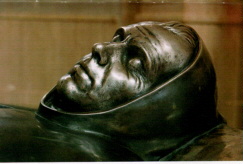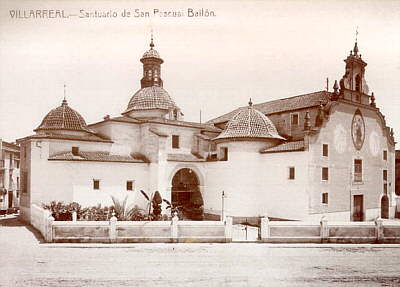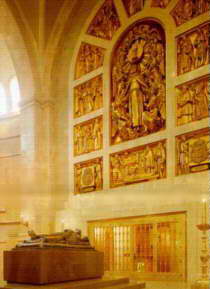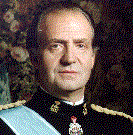 |
|
 |
|
 Pascual
Baylon-Yubero was born in Torrehermosa, Aragon, Spain, the 16th of May
1540, Pentecostes day. Devote to the Eucharist since his childhood, arrives
to the Valencia Kingdom as young sheepherd and joins the Franciscan order
of the Discalced Carmelitans. It wears the monk dresses in the city of
Elche and professes in Orito the 2nd of February 1565. Having an ascetic
and mystic personality, develops his eucharist faith thru charity and
brotherhood and defends it against non-believing persons attacks. After
a life during which he cultivated his spirit with the Prye, the writing
and by doing the most modest secular jobs in several monasteries around
the area -named Provincia de San Juan Bautista-, he died
in Vila-real the 17th of May 1592, also Pentecostes day.
His death happenned at the very moment of the Eucharist Consagration during
the Mass. After dying, his body opened his eyes to adore the Blessed Sacrament.
Pascual
Baylon-Yubero was born in Torrehermosa, Aragon, Spain, the 16th of May
1540, Pentecostes day. Devote to the Eucharist since his childhood, arrives
to the Valencia Kingdom as young sheepherd and joins the Franciscan order
of the Discalced Carmelitans. It wears the monk dresses in the city of
Elche and professes in Orito the 2nd of February 1565. Having an ascetic
and mystic personality, develops his eucharist faith thru charity and
brotherhood and defends it against non-believing persons attacks. After
a life during which he cultivated his spirit with the Prye, the writing
and by doing the most modest secular jobs in several monasteries around
the area -named Provincia de San Juan Bautista-, he died
in Vila-real the 17th of May 1592, also Pentecostes day.
His death happenned at the very moment of the Eucharist Consagration during
the Mass. After dying, his body opened his eyes to adore the Blessed Sacrament.
Nominated beatus by pope Paul V on 19th of October 1618. Became Saint by pope Alexander VIII, on 16th October 1690. Patron Saint of all Eucharistical Associations and Congresses by pope Leo XIII, on 28th November 1897. Patron Saint of the Segorbe-Castellon Spanish catholic demarcation by John XXIII on 12th May 1961. Patron Saint of Vila-real and other cities and main Saint of many churches, parishes and monasteries all over the catholic community worldwide, as well as of the Spanish Royal House.
Last year, more than 100,000 devots from all over the world came to Vila-real to visit his Sanctuary, where his remains are preserved.
The Discalced Carmelitans, (Franciscan friers reformed by Saint Pedro de Alcántara, therefore also called Alcantarians), arrived to Vila-real in 1577 in order to found a monastery. From the hermitage of Virgin Mary of Grace, where they were located originally, they moved in 1578 to the hermitage of Virgin Mary of the Rosary, which was offered by the local authorities. This location, in the outskirts but closer to the village, made their tasks easier and became a starter for the building up and naming the present Alcantarian monastery. This austere building is where Pascual Baylon spent his last years.
 The
Old Saint Pascual Sepulchre
The
Old Saint Pascual SepulchreAfter prier Pascual death and his nomination as Beatus, the big amount of visitors to his momified remains Sepulchre forced to build up a digne and capable chapel. In 1680 the works finished, being the building considerated the first monument from the Valencian Baroque style by age and merits. Following the devotion from his predecessors, Carlos II King of Spain implemented the Royal Patronage for the Chapel in 1681. In 1691, for the commemoration of the canonization and the century of the Saint's death, a glass urn was made then allowing his uncorrupted body to be seen.
As a result of the end of the cloisterhood in 1835, the Alcantarian monks had to leave the monastery. In 1836 the Mother Clarisas moved in from their original convent in Castellon. These nuns, dedicated to the "contemplative live", are still today taking care of the Sepulchre and watching over the Blessed Sacrament, permanently shown to the public in the main altar of the Sanctuary.
 At
the beginning of the Spanish Civil War in 1936, the Sepulchre was profaned,
being the Royal Chapel and the original Church burned up and destroyed,
including Saint Pascual's incorrupted body. In 1942, three years after
the War finished, the foundation stone was set for the reconstruction and
some years after the works started to build the "Saint Pascual's International
Eucharistic Votive Church", raised up beside the old monastery remains,
with a plan to rebuild the Royal Chapel and Sepulchre in
front to Saint Pascual's cell, where the remains that were recovered from
the fire could be shown to the public. The Church, even without being finished,
was open to cult in 1971 and was consecrated in 1974.
At
the beginning of the Spanish Civil War in 1936, the Sepulchre was profaned,
being the Royal Chapel and the original Church burned up and destroyed,
including Saint Pascual's incorrupted body. In 1942, three years after
the War finished, the foundation stone was set for the reconstruction and
some years after the works started to build the "Saint Pascual's International
Eucharistic Votive Church", raised up beside the old monastery remains,
with a plan to rebuild the Royal Chapel and Sepulchre in
front to Saint Pascual's cell, where the remains that were recovered from
the fire could be shown to the public. The Church, even without being finished,
was open to cult in 1971 and was consecrated in 1974.
 On
the 17th of May 1992, Saint Pascual's day, 4th centenary of his death,
the current King of Spain Juan-Carlos I
inaugurated the Royal Chapel and presided the Saint's remains
move to the new Sepulchre. Both works, by the local painter and sculptor
Llorens-Poy, are part of the current Sanctuary.
On
the 17th of May 1992, Saint Pascual's day, 4th centenary of his death,
the current King of Spain Juan-Carlos I
inaugurated the Royal Chapel and presided the Saint's remains
move to the new Sepulchre. Both works, by the local painter and sculptor
Llorens-Poy, are part of the current Sanctuary.
In
the centre of the Chapel, a dark granite sarcophagus with a lying
image of Saint Pascual made of silver, inspired in his incorrupted
body. In the rear wall, the cell where Saint Pascual died, integrated in
a 14 metres high altarpiece.
Some other interesting pieces with an artistic and historic value, ranging
from 16th to 20th centuries, preserved from the 1936 fire, are today shown
in the "Pouet del Sant" -well of the Saint- lounge. The
waters from this well dated 1589 are very appreciated by the Saint devots.
The cloister and refrectory, including the seat where Saint Pascual used
to sit are also visitable.
 |
|